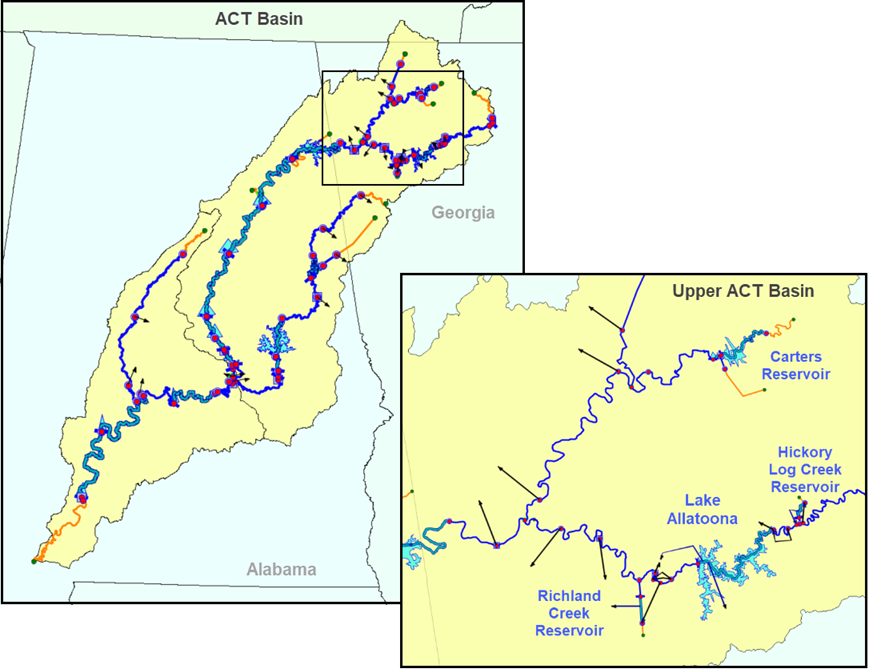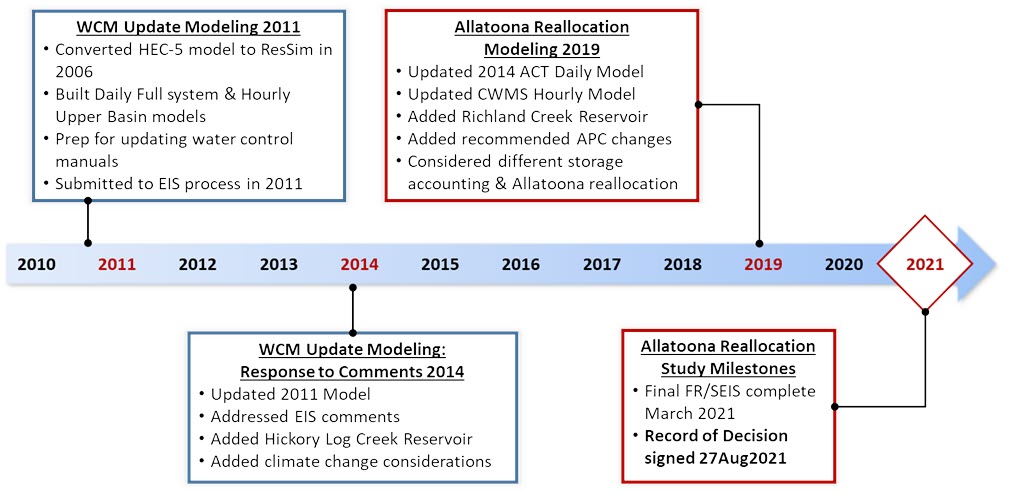Download PDF
Download page Alabama-Coosa-Tallapoosa HEC-ResSim Modeling.
Alabama-Coosa-Tallapoosa HEC-ResSim Modeling
By Sara O’Connell, P.E.
The Hydrologic Engineering Center (HEC) has been involved with modeling reservoir operations in the Alabama-Coosa-Tallapoosa (ACT) and the Apalachicola-Chattahoochee-Flint (ACF) River Systems for over thirty years. These two basins in the South Atlantic Mobile District (SAM) run through Georgia, Alabama, and in the case of ACF, Florida (Figure 1). With the increasing demand from the ever-expanding Atlanta metro population and environmental concerns, particularly in Apalachicola Bay, water in the region is hotly contested. A long and contentious three-state battle for water in the basins is ongoing, and often the Corps gets caught in the debate. Reservoir modeling is helpful for supporting the analysis of current and future conditions and the impact of any proposed operational changes.

Six multipurpose federal projects exist within the ACT, and there are an additional twelve major non-federal reservoirs, several of which are owned and operated by the Alabama Power Corporation (APC). Some of the projects are jointly operated between APC and USACE, and a Master Water Control Manual is used to manage the system as a whole. Purposes of the reservoirs include water supply, fish and wildlife, hydropower, flood risk reduction, navigation, and recreation interests. Given the pressures of increasing population, additional private water supply augmentation dams have been recently proposed and built on various tributaries in these basins. These dams provide a higher level of water supply security, allowing water to be pumped from the main stem river into storage on a tributary. A few of these projects have been successfully permitted including Hickory Log Creek Reservoir, constructed in 2014, and Richland Creek Reservoir, which was under construction as of 2019.
HEC’s involvement in ACT (and ACF) reservoir modeling began with the HEC-5 software in the late 1980’s. Around 2006, HEC began upgrading the HEC-5 models to the early HEC-ResSim software in response to various operational questions and in preparation for updating the system’s Water Control Manuals. The effort to update the Water Control Manuals, which included development of an Environmental Impact Statement (EIS), lasted for many years, with modeling completed in 2014 and a Final EIS issued in 2015. During that time, a request by the State of Georgia for additional water supply storage and changes to storage accounting practices at Allatoona Lake was not included in the scope of the 2015 WCM update, due in part to the additional effort and time the analysis would require in an already lengthy process. In January 2018, the U.S. District Court for the Northern District of Georgia issued a judgment holding that USACE had unreasonably delayed action on Georgia’s water supply request, and directed USACE to respond to that request by March 1, 2021. Thus HEC was again requested to assist in modeling scenarios on the ACT Basin.
The State of Georgia’s water request involves the water storage accounts and accounting practices at Allatoona Lake. Allatoona Lake contains storage accounts for two users: Cobb County-Marietta Water Authority (CCMWA), which serves the Atlanta metro area, and the City of Cartersville, just downstream of Allatoona. Each account holder has a portion of the conservation pool volume allocated to their use (4.6% and 2.2%, respectively) and a permit to withdraw their relative proportion of the Allatoona firm yield. Daily water storage accounting tracks account balances by distributing pool inflows and deducting withdrawals from each account.
The CCMWA and Cartersville permits at Allatoona originally corresponded to an anticipated yield of about 51 million gallons per day (mgd), but sedimentation in the reservoir has reduced the total firm yield, and thus the account yield. The current anticipated yield of the combined accounts is only 34 mgd, while the updated Georgia water supply request is for a total of 94 mgd. While the construction of the Richland Creek augmentation reservoir will assist in meeting some of the CCMWA demand, it is not sufficient to address the full future needs. Some reallocation of Allatoona Lake would be required – either from the conservation pool or from the conservation and flood pools. Georgia has also requested a different approach to water storage accounting methodology. The key differences between the current storage accounting practices and the Georgia request involve the determination of when the accounts should be considered full, the determination of the percent of inflow that should be credited to each account holder, and whether to give account holders full credit for their return flows.
HEC developed ResSim model alternatives corresponding to the study team’s key alternatives. Initial modeling goals were to update the firm yield analysis and establish the boundaries of potential reallocation from the flood and inactive pool to meet Georgia’s request. Both storage accounting methodologies were modeled. Alternatives also considered flood pool reallocation at APC-owned projects, Weiss and Logan Martin, and other operational changes proposed by APC. In addition to the daily timestep model, the local Corps Water Management System (CWMS) hourly timestep model was adjusted in order to perform flood modeling and a Probable Maximum Flood dam safety check. The daily model also supported the water quality modeling with the HEC-5Q software. These models assisted in impact analysis for implementing Georgia’s request, as well as several reasonable alternatives.
Over the years, a rotating cast of employees has conducted the reservoir modeling, as some careers have begun and others retired. The current HEC team consists of Leila Ostadrahimi, who continues to be a modeling powerhouse, Daniel Black, honing his quickly acquired HEC-ResSim skills with the flood modeling, Joan Klipsch offering overall HEC-ResSim wisdom and support, and myself, managing the project and aiding in modeling and documentation where needed. Our HEC team continued to work directly with James Hathorn of Mobile District, who as always, is a privilege to work with, a model of grace and leadership.
2022 Update
The ACT ResSim modeling supported the Allatoona Lake Water Supply Storage Reallocation Study and Updates to Weiss and Logan Martin Reservoirs Project Water Control Manuals. The study team completed a final Feasibility Report and Supplemental EIS in March 2021 (Figure 2). In August 2021 the Civil Works Assistant Secretary of the Army selected a plan and signed the Record of Decision. The Selected Plan differed from the USACE’s Recommended Plan, largely in the use of the State of Georgia’s proposed water accounting method, which, by giving full credit for returned flows, did not require any reallocation of the Allatoona Flood Pool. As commented by James Hathorn, “This decision is a milestone because it sets a precedence of allowing full credit for the man-made flows. The impacts will ripple through other district offices involved in reallocation studies.” The Mobile District is finishing updates to the Water Control Manuals and expect them to be complete by the end of March 2022.
